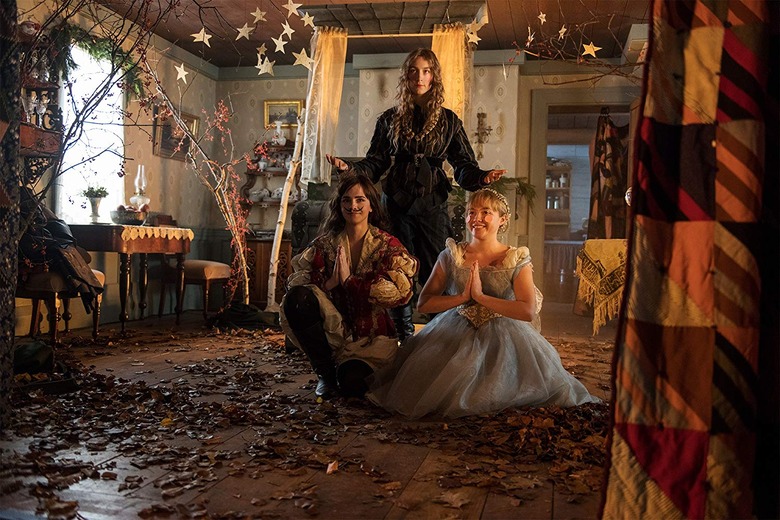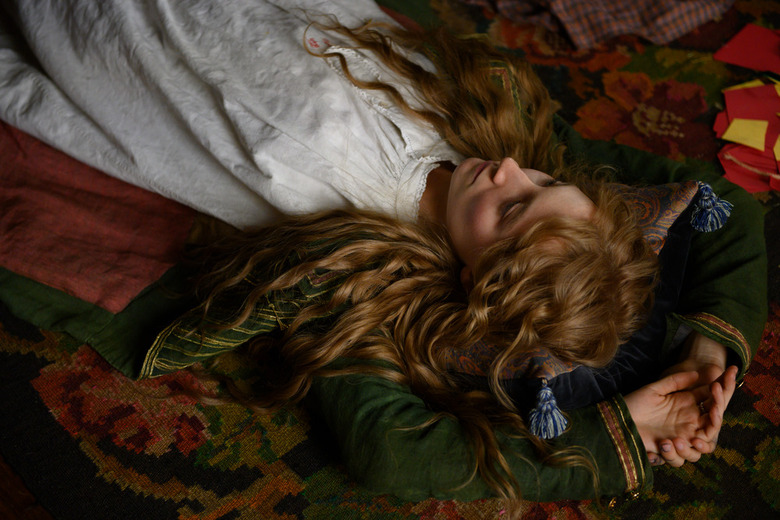Why The Wildly Different Women Of 'Little Women' Make It Such An Enduring Classic
Are you a Jo or an Amy? Personality tests that identify you as part one Little Woman character, part this breed of dog, seem like a new digital invention — made to power Buzzfeed's traffic or create conversations centered around "OMG you're such a Miranda!" But personality tests reach far back as ancient times, and I'm not just talking about the mid 19th century when Louisa May Alcott first published her classic novel Little Women.
One of the elements that makes Little Women such an enduring classic is the four women at the center of it, and the four wildly different personality types they represent: Meg, the responsible and forever compromising one; Jo, the fiery and ambitious one; Beth, the sensitive and shy one; Amy, the vain and social one. Every reader of Alcott's book could identify with at least one of the characters, though they almost always aspired to be the tomboyish, indomitable Jo. Alcott by no means invented these personality types when she published her book in 1868, nor would she be the last to convey them by such clear delineations: just look at the ambitious one, the sensitive one, the sexy one, and the leader of Sex and the City, or the four mutant ninja turtles of Teenage Mutant Ninja Turtles. Look at how we label the members of boy bands! They're all similar personality types (barring maybe the sexy one of TMNT) that stretch back to ancient Greek tradition and the concept of the four temperaments.
Four Women, Four Temperaments
Hailing from ancient Greek proto-psychology, the four temperaments theory boils down personality types to four fundamental ones: sanguine, choleric, melancholic, and phlegmatic. These four temperaments are rooted in the ancient Greek medical concept of the four humors — the idea that fluids within the body affect human behavior. These fluids would be classified as blood, yellow bile, black bile, and phlegm, and each had their own traits associated with them, which would evolve into the four temperaments. The sanguine personality is the sociable, charismatic one; the choleric is the ambitious, independent one; the melancholic is the deep thinker and feeler; and the phlegmatic is the compromising peacekeeper.
It's easy to see where the women of Little Women fall among these personality types: Amy is sanguine, Jo is choleric, Beth is melancholic, and Meg is phlegmatic. Though we meet Amy as a young ridiculous girl who puts on the airs of a lady, she is clearly the most charismatic and sociable of the four, and the most avid social climber. But while Amy grows into her archetype (and defies its trappings), the other three are very firmly defined by their temperaments. Jo is the de facto leader of the group, the driven, ambitious, and independent sister who leads the girls on merry stage productions. Beth is the deep feeler and moral conscience of her sisters whose life revolves around her family. Meg is the eldest and by nature the peacekeeper, though her attempts are often met with cheery defiance.
These clear personality types make it easy to distinguish the four girls and — like many a story that revolves around these temperaments — end up becoming a seminal part in shaping readers' own identities. Perhaps they identify with Meg and want to be more like Beth, or they see too much of themselves in Amy and become resentful of it. But the beauty of Little Women is that it doesn't judge or mock any of these personality types. "Just because my dreams are different than yours, it doesn't mean they're unimportant," Meg gently says to a bitter Jo, who can't accept that her sister would choose the confines of marriage over a life on the stage. Alcott, who herself never bowed to the limited expectations for women at the time, would not constrain her characters to basic archetypes without highlighting the strengths, and flaws, in each of them. Her characters grow beyond their archetypes or upend our expectations of what that archetype entails. The vain, preening Amy turns out to be a pragmatic and emotionally intelligent woman; vice versa the independent Jo sees her hotheaded ways become an obstacle for her, while Meg's compromising nature leads to her feeling forever entrapped.
By using these four temperaments as jumping off points for the March sisters' coming-of-age, Alcott captures that uncertain transition between childhood and adulthood — from knowing how the world works and how everyone fits in their neat little boxes, to not knowing anything at all. It's a sentiment that Greta Gerwig perfectly nails in her 2019 adaptation.
My Dreams Are Different Than Yours
As the characters of Little Women grow beyond their archetypes, we can see them as more than the sensitive one or the independent one. But on the other side of that growth isn't always sunshine and rainbows, as the characters find that becoming their own selves is difficult, it's hard, it's thankless. Adulthood is that way.
No one had clung to that rosy childhood harder than Jo (Saoirse Ronan), whose one constant throughout all adaptations of Alcott's story is her fierce loyalty to her family and her anger at the inevitable change. As the sisters head into adulthood — marked by the marriage of the eldest sister Meg (Emma Watson) — their de facto leader, Jo, abandons them to chase her dreams in New York while Amy (Florence Pugh) heads to Europe and the sickly Beth (Eliza Scanlen) stays at home. The disintegration of childhood is as deeply felt as the fracturing of this close-knit group.
Gerwig plays up the contrast between these two time periods with differing color palettes — the literal warm, orange glow of childhood versus the stark whites and grays of adulthood. But it's more than just color schemes that mark this difference, it's in the hesitation when the sisters speak to each other, and in the lingering resentment that simmers under the surface. "Amy has always had a talent for getting out of the hard parts of life," Jo caustically remarks of her youngest sister, who remains ignorant of Beth's worsening condition. Lines like these cut through the soft coziness of the childhood scenes, hinting that the hurts the sisters inflicted on each other when they were young never really fade, and that the differences between two very different personalities can never be totally overcome. This is where Gerwig's modern touch comes in to enhance Alcott's already progressive portrayal of four wildly different personalities that nonetheless complete each other. Alcott already took the March sisters out of their boxes, but Gerwig destroys those boxes completely, and we're left with characters who can't be defined by one singular trait or characteristic. Even Beth, the force of purity among the sister whose goodness (and scarlet fever) dooms her to a short life, gains a humanity beyond her archetype. All the sisters are a mess of flaws and strengths and little nuggets of wisdom.
"When did you get so wise?" Jo later asks Amy, after they have finally reunited after long years apart. "I always have been. You were too busy noticing my faults," Amy cheekily responds.
It isn't until this reunion that the two of them finally see each other as human beings, faults and wisdom and all. It's messy and undefinable, and utterly human.


